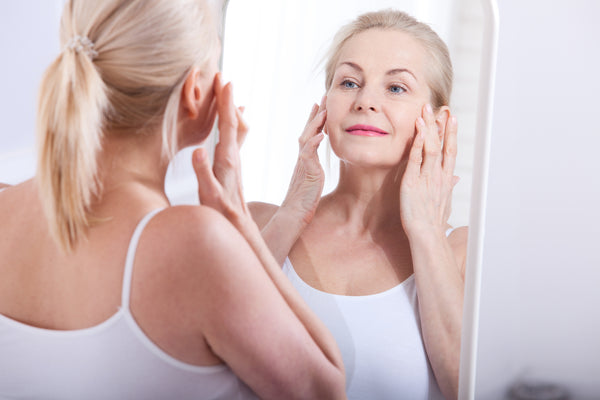Boosting NAD+ Protects Sun-Damaged Skin, From the Inside Out

From guarding against germs to protecting us from the elements to physically holding our organs and tissues in place, our skin takes the brunt of the damage from our day-to-day activities. Despite its tough yet flexible exterior, the skin is subjected to various forms of dysfunction as the decades go by — especially from excessive ultraviolet (UV) exposure from the sun.
New research out of Japan aimed to determine if one answer to treating UV-induced skin damage lies with the compound NAD+ (nicotinamide adenine dinucleotide). NAD+ levels deplete with advancing age, leading to accelerated disease development and organ dysfunction — including our body’s largest organ, the skin. Now, Katayoshi and colleagues show that repleting lost NAD+ in the skin after UV exposure with the NAD+ precursors, NMN (nicotinamide mononucleotide) and NR (nicotinamide riboside), may present as an option for treating or preventing both the internal and external signs of skin aging.
The Necessity of NAMPT
Concurrently with the age-related drop in NAD+ levels, the enzyme NAMPT (nicotinamide phosphoribosyltransferase) exhibits a similar decline in activity. NAMPT is a rate-limiting enzyme — one whose activity determines the overall speed or rate of a reaction — in the primary pathway that we use to make NAD+ from a related compound called nicotinamide; this is known as the NAD+ salvage pathway. With this age-related reduction in NAMPT activity are further reductions in cellular NAD+ levels.
Previous research has found that inhibiting NAMPT in cell-based studies causes senescence — an irreversible growth arrest that leaves cells in a zombie-like state, where they remain dysfunctional in the body and leave a trail of inflammatory debris behind. UV irradiation, especially from UVB rays, plays a pivotal role in skin cell senescence, leading to accelerated photoaging — premature skin aging due to repeated light exposure.
Although some studies have looked at how NAD+ precursors like NMN mitigate UV-induced skin damage, we haven’t yet uncovered how NAMPT plays a role in this process. In this study, Katayoshi and colleagues show that adequate NAMPT activity is necessary to protect skin cells from damage after UV exposure. However, they also find that NMN and NR can take over if NAMPT isn’t available to do the job, as directly supplementing with these precursors bypasses the part of the NAD+ salvage pathway that requires NAMPT.

Keeping Keratinocytes Alive and Kicking
First, Katayoshi and colleagues looked at how NAD+ and NAMPT levels changed in keratinocytes — specific cells found in the outermost skin layer called the epidermis — immediately after UV exposure. One hour post-irradiation, NAD+ levels in the cells markedly dropped to their lowest point, with gradual restoration to 80% of original levels at 8 hours after UV exposure.
This immediate decline in NAD+ is likely due to rapid consumption by an NAD+-dependent protein called PARP1 (poly [ADP-ribose] polymerase 1), whose primary function is to repair DNA that was damaged from the UV irradiation. Conversely, NAMPT levels markedly increased after irradiation, suggesting that NAMPT’s activation is prompted by the loss of NAD+ to restore NAD+ balance in the cells.
Katayoshi and colleagues hypothesized that NAMPT would restore depleted NAD+ after irradiation. To test this, they inhibited NAMPT activity after UV irradiation, finding that the previously seen NAD+ repletion was blocked entirely. In addition, the absence of NAMPT activity in the keratinocytes increased cellular senescence.
This indicates that NAMPT is vital to repleting NAD+ stores after UV radiation, preventing ATP (energy) deficiency and dysfunctional cell growth processes. And, because NAD+ is rapidly repleted with proper NAMPT activity, the NAD+-dependent longevity-promoting protein called sirtuin-1 (SIRT1) can also function better. As the authors state, “Our results indicate that NAMPT plays a pivotal role in the skin cells’ recovery from UV damage in mild doses.”
Supporting the Skin With NMN and NR
Lastly, Katayoshi and colleagues looked at what happens after treating the keratinocytes with two NAD+ precursors, NMN and NR, while simultaneously inhibiting NAMPT. The previously seen inability to replenish lost NAD+ post-irradiation was mitigated by the addition of NMN and NR. This indicates that these precursors can boost NAD+ and preserve skin cell integrity and energy without requiring the typical NAMPT-mediated NAD+ synthesis pathway.
Although supplementing with NMN and NR are straightforward solutions to potentially fighting age-related skin damage, there are no NAMPT supplements to boost the activity of this enzyme. However, some research has shown that resveratrol in red grape skins and a group of antioxidant compounds called anthocyanidins (found in plants with red, blue, or purple pigments) have been shown to increase NAMPT levels.
Plus, although NMN does not convert into NAMPT, NMN directly enters cells and converts into NAD+. Any unused components of the NAD+ molecule — typically nicotinamide — are recycled through the NAD+ salvage pathway, which then provides additional starting fuel to create more NAD+.

The Future of Fighting Photoaging
In this study, the Japan-based research team uncovered previously unknown mechanisms behind how our skin cells respond to and recover from stressful situations like UV irradiation. In the future, compounds that boost NAMPT activity, or NAD+ precursors like NMN and NR, may soon be used to prevent or treat skin photoaging from excessive UV exposure.
As Katayoshi and colleagues conclude, “Our findings not only provide a conclusive explanation for the involvement of NAMPT in skin protection against daily UVA/B exposure but also identifies novel candidate molecules, NMN and NR, as potential therapeutic and preventive agents for age-associated skin disorders and functional decline.” In the meantime, don’t forget to wear your sunscreen.
References:
Huang P, Riordan SM, Heruth DP, Grigoryev DN, Zhang LQ, Ye SQ. A critical role of nicotinamide phosphoribosyltransferase in human telomerase reverse transcriptase induction by resveratrol in aortic smooth muscle cells. Oncotarget. 2015;6(13):10812-10824. doi:10.18632/oncotarget.3580
Katayoshi T, Nakajo T, Tsuji-Naito K. Restoring NAD+ by NAMPT is essential for the SIRT1/p53-mediated survival of UVA- and UVB-irradiated epidermal keratinocytes [published online ahead of print, 2021 Jun 12]. J Photochem Photobiol B. 2021;221:112238. doi:10.1016/j.jphotobiol.2021.112238







